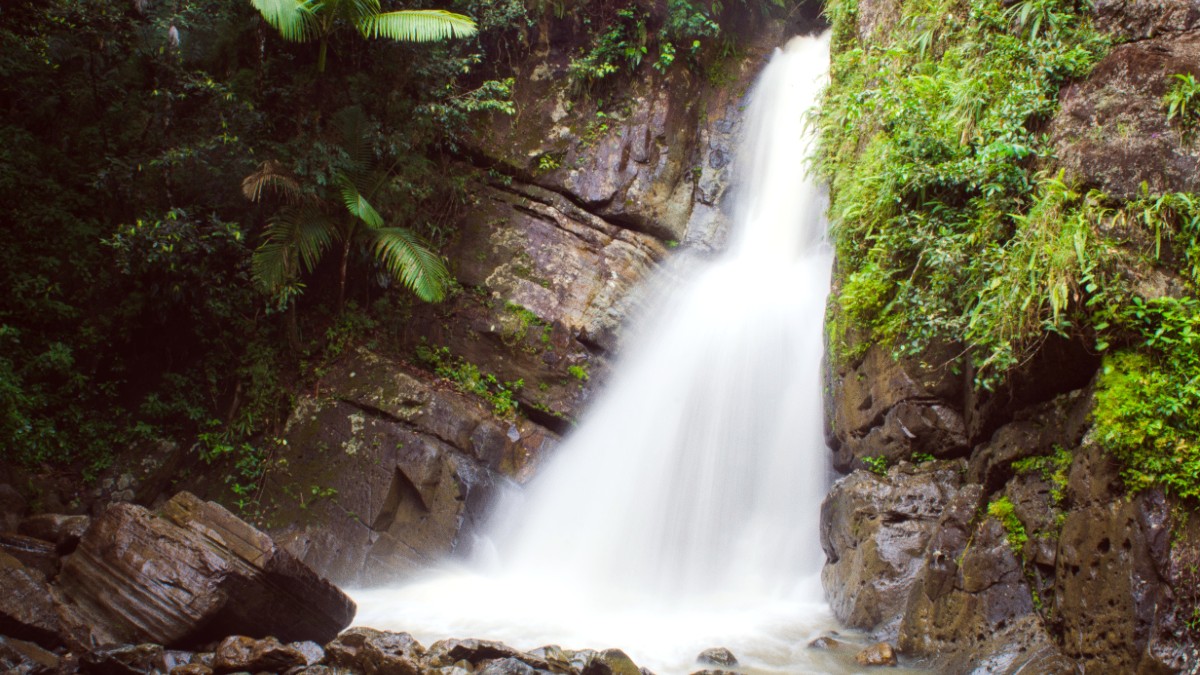
Eastern Puerto Rico, Puerto Rico
Pack layers. Lower trails are humid and warm, while higher elevations are cooler and often misty.
The forest receives an astounding amount of rain, over 100 billion gallons annually. The rainforest pulses with life. The air often feels thick with moisture, carrying the scent of damp earth and flowering plants.
The sound of water is ever-present, from the gentle drip of leaves to the roar of cascades.
El Yunque National Forest sits in eastern Puerto Rico. It spans parts of the Río Grande and Luquillo municipalities, approximately 40 miles (64 kilometers) east of San Juan. This location makes it easily reachable by car from the island's main international airport, Luis Muñoz Marín International Airport (SJU), a plus for many travelers.
The forest covers about 28,000 acres (113 square kilometers). Its terrain is rugged, shaped by volcanic activity and millennia of erosion. Elevations range from 100 feet at the base to 3,494 feet (30 to 1,065 meters) at its highest point, El Toro Peak. This varied elevation creates a series of distinct ecological zones, from the warmer, lower tabonuco forest to the cooler, cloud-shrouded dwarf forest at the summit. Steep slopes characterize the landscape. These slopes, combined with high annual rainfall, funnel water into numerous rivers and streams. These waterways carve through the forest, forming the many waterfalls and natural pools that visitors seek. The constant flow of water sustains the forest's immense biodiversity. The unique geography gives rise to specific microclimates within the forest. Lower elevations experience warmer temperatures, while higher parts are consistently cooler and enveloped in mist. This constant moisture leads to an incredibly lush environment. The forest’s position, facing the prevailing easterly trade winds, captures moisture from the Atlantic Ocean, contributing to its status as one of the wettest places on Earth. This geographical setup attributes to its rich, tropical rainforest character, unlike any other forest found in the continental United States. The driving journey to El Yunque from San Juan transitions from urban sprawl to coastal towns, then gently climbs into the verdant, rolling foothills, offering a gradual immersion into its natural splendor.
Name "Yuke" or "Yuque" from Taíno word for "sacred lands". Believed dwelling place of Yuquiyú, god of fertility and storms. Petroglyphs remain.
Spanish recognized timber value, enacted regulations against exploitation. Early form of conservation.
Designated forest reserve in 1903 (Luquillo Forest Reserve). Renamed Caribbean National Forest in 1935.
Official renaming honored Taíno heritage and reaffirmed cultural roots.
Over a century of scientific studies. Gaining insights into tropical ecosystems, biodiversity, and climate change.
A visit to El Yunque is not just about seeing nature. It is also about experiencing a place steeped in layers of human history, from ancient spiritual reverence to modern scientific exploration and conservation. The echoes of the Taíno, the Spanish, and generations of conservationists resonate through its trails and valleys.
The forest homes remarkable plant and animal life. Over 240 species of native trees flourish here, along with hundreds of other plant species, including orchids, bromeliads, and giant ferns. This plant diversity creates a complex habitat for a wide array of wildlife.
Look for the critically endangered Puerto Rican parrot, a symbol of the island's conservation efforts. Various species of coqui frogs, tiny arboreal frogs endemic to Puerto Rico, are perhaps the most iconic inhabitants. Their distinctive "co-qui" call fills the air, especially at dusk, creating the forest's signature soundscape. El Yunque presents a chance to witness nature’s intricate balance and raw power.
El Yunque National Forest is a symbol of biodiversity and natural splendor. It is a biodiverse tropical rainforest, demonstrating abundant vegetation, many waterfalls, and an extensive network of hiking trails. This positions it as a premier destination for ecotourism, hiking, birdwatching, and nature photography in Puerto Rico.
Discover the captivating features within El Yunque, each offering unique experiences for visitors.
Reservations are often needed for entry to El Portal and for accessing the main road into the forest, especially during peak times.
This 69-foot observation tower presents stunning panoramic views. From its top, visitors see a sweeping vista of the forest canopy, extending out to the Atlantic coastline. It presents an early and impressive introduction to the forest's scale and beauty.
These are a series of smaller, less developed waterfalls and natural pools. They present a more secluded swimming experience compared to La Mina, accessible via a short trail that requires some careful footing due to slippery conditions.
Located at a higher elevation, this stone observation tower presents breathtaking views. The hike to Mount Britton presents a moderate challenge and rewards with expansive vistas, often above the cloud line, where the dwarf forest ecosystem is prominent.
While La Mina Falls is historically a beloved swimming spot, it is currently under restoration. Please check official sources for current access.
Closure underscores ongoing efforts to restore the forest's infrastructure post-hurricanes.
Warmer temperatures, extensive canopy cover, home to giant tree ferns. First zone encountered by visitors.
Characterized by the distinctive red-barked Palo Colorado trees. Cooler and wetter than lower zones.
Highest elevations, constantly shrouded in mist. Stunted trees covered in moss and epiphytes. Unique adaptations.
El Yunque is a area for global biodiversity research, studying tropical ecosystem dynamics.
Ongoing studies track the results of climate change on rainforest species and water resources.
Post-hurricane recovery and reforestation efforts are active to restore damaged areas.
Take time to listen to the sounds of the forest, from coqui calls to rushing water. Observe without disturbing.
Stay on marked trails to protect fragile ecosystems and for your own safety.